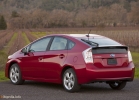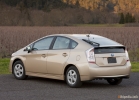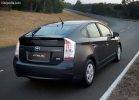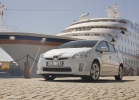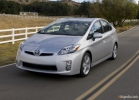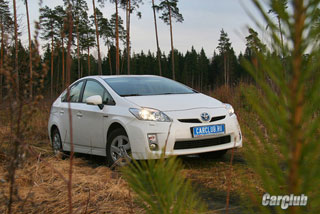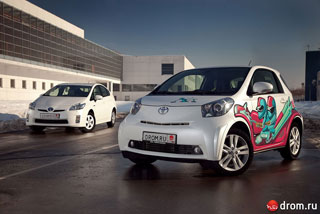Toyota Prius test drive since 2009 hatchback
Toyota Prius test drive: Dear savings
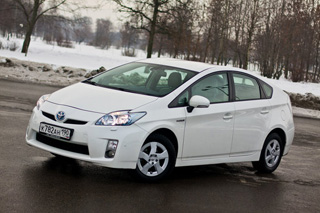 The Kolesa.ru portal succumbed to the western trend and spent three weeks, saving fuel and minimally polluting the environment, along with the most inexpensive hybrid car of the Russian Toyotoy Prius market.
The Kolesa.ru portal succumbed to the western trend and spent three weeks, saving fuel and minimally polluting the environment, along with the most inexpensive hybrid car of the Russian Toyotoy Prius market. Hybrid cars or just h on Russian roads are more and more often found on Russian roads. Still would! After all, Russian representative offices of eight automobile concerned show rooms with cowardly models. Unfortunately, almost all of the cars presented belong to the premium class and are inaccessible to most buyers due to a very high price. And those who can afford to pay several million rubles for an innovative car are often chosen not economical, but rather the most powerful of the proposed options. These are the features of our automobile mentality.
By the way, this is perfectly understood in Lexus, which is a record holder both in the number of hybrid models in the gamut and their sales. The fact is that hybrid versions of Lexus models are both the most powerful modifications. And Russian buyers of the premium Japanese brand, in most cases, buy not hybrid technology, but the number of horsepower.
We decided to test, so to speak, the Toyota Prius folk hybrid. Of course, it can’t be called cheap: the basic cost is 1,189,000 rubles, and the tested car is 1,395,000 rubles. However, whatever one may say, the most affordable car of the Russian market with a benzoelectric power plant. Largely, thanks to this, in 2011 225 cars were sold in Russia, that is, each car every one and a half days, which is not so bad.
So we will try to put ourselves in place of the potential owner and evaluate all the features of an unusual model.
The unusual of the Prius is immediately emphasized by appearance. Although, formally, the car belongs to the popular golf class and is an ordinary five-door hatchback, the designers managed to create an image that is immediately distinguished from the stream of classmates. Of course, it will hardly turn out to call a handsome priest, however, there is some elusive attractiveness in his exterior, which, until recently, were deprived of the rest of the Toyota models.
Now about the most interesting, power plant. If you do not delve into technical details, it has a prose of Toyota consists of four parts: an internal combustion engine, an electric motor, a generator motor and a high-voltage battery.
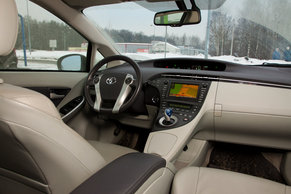
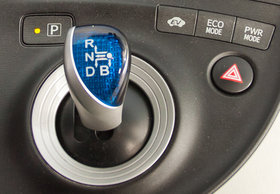
The basis of the driving force is the gasoline engine of the Atkinson system with a volume of 1.8 liters and a capacity of 99 horsepower, which, in addition to moving the front wheels of the Prius, is also a source of energy for the generator, which immediately transfers it to the traction electric motor. In addition, during the stops, the generator fies the battery with the ICE turned on, and, in fact, is a starter for it.
The electric motor helps both the internal combustion engine, providing it with additional thrust and the charging of the high -voltage battery, which the electric motor transfers the energy received from recuperative braking.
The Panasonic battery itself is 37 horsepower by a source of traffic with a gasoline motor disconnected, completely turning the Toyota into an electric car.
Synchronization of the operation of all elements of the power plant is carried out by means of a computer. The driver can only choose a movement mode: EV electric car mode, Eco Mode mode of maximum fuel savings and Power Mode mode of maximum return of the entire power plant.
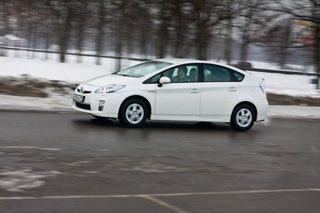 It is worth noting that in the EV mode of Prius can pass no more than two kilometers and no faster than 33 km/h, and you need to press the gas pedal very smoothly, otherwise the gasoline engine will inevitably connect, reporting on intense acceleration. A feature of work in other modes is the fact that Toyota Prius does not have an idle move: a hybrid hatchback is touched exclusively on the electric trough with the subsequent connection of the internal combustion engine and stalls as soon as the right leg reduces the pressure on the accelerator pedal.
It is worth noting that in the EV mode of Prius can pass no more than two kilometers and no faster than 33 km/h, and you need to press the gas pedal very smoothly, otherwise the gasoline engine will inevitably connect, reporting on intense acceleration. A feature of work in other modes is the fact that Toyota Prius does not have an idle move: a hybrid hatchback is touched exclusively on the electric trough with the subsequent connection of the internal combustion engine and stalls as soon as the right leg reduces the pressure on the accelerator pedal. Despite all the complexity of the design, we were not able to complain about the test of engines for all the test, given even those facts that the experimental prose managed to run about 30,000 km and catch 25-degree frosts. The gasoline engine was always connected without any failures, and he did it very delicately, without causing attacks of irritation.
The Power mode was pleased with the dynamics: a 1.5-ton priest, and even with the variator, accelerated very confidently, however, to the distinct sound of the gasoline engine. In general, noise insulation is not the main trump card of Toyota Prius, as well as the energy intensity of the suspension. The hybrid Japanese firmly passes the irregularities of the road, reviving, moreover, the entire salon plastic.
But fuel consumption will definitely please the potential owner. Of course, we could not meet the declared 3.9 liters per 100 km of the city (!) Run, and we did not really believe in a similar result. However, with a fairly active ride with regular inclusion of Power, gasoline consumption in the city did not exceed 7.3 liters per hundred, and on the highway amounted to 5.2 liters. Given the traffic jams and 20 degree frosts, this result looks very worthy.
A source: Wheel magazine [March 2012]

